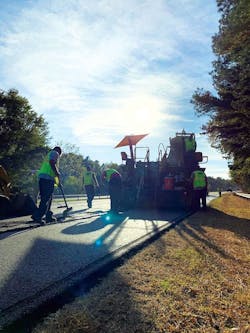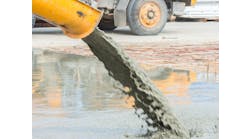A no-cost design change and first-try use of foamed asphalt yields a brand new road near Clemson University
By: Brian W. Budzynski
Sometimes, when it comes to project design, your contractor knows best.
In the case of the planned rehabilitation of 7 miles of U.S. Highway 123 in Pickens County, South Carolina, the South Carolina DOT (SCDOT) quickly acceded to a large-scale change suggested by contractor King Asphalt—one that would completely reenvision both the scope of the project and the quality of the resulting rehabilitation, and earned the 2020 Roads & Bridges/ARRA Recycling Award for Full-Depth Reclamation.
“This project was originally bid as a patch, mill, widen, and pave,” King Asphalt President Mike Crenshaw told Roads & Bridges. “There were approximately 200,000 sq yd of pavement out there. Over half the pavement was severely deteriorated and needed some type of repair. SCDOT had only 35,000 sq yd of full-depth patching available for the project. The project would then be widened by 2 ft on the inside and outside shoulders, milled, and an intermediate layer would be placed followed by a surface layer. That’s the way it was originally bid.”
King quickly ascertained that such a limited scope would not achieve SCDOT’s ultimate goal of road restoration.
“The problem with that,” Crenshaw went on, “was that the entire right lane, both to and from, was completely falling apart. It was impossible to figure out where to start and stop patching. Knowing that, and having done other sections adjacent to this project, we felt that there had to be a better approach to repairing this road. This was when the thought of cold in-place reclamation (CIR) for this project was born. We formulated a plan and presented a no-cost-change order, value-engineered redesign to SCDOT. They liked it and they took it, which meant we were able to treat the entire roadway, instead of just those 35,000 yd of patchwork. The entire road got rebuilt.”
A matter of trust
Every new process adaptation requires trust between the contractor and the DOT, and this initial—and crucial—demonstration of trust formed the bedrock of what would ultimately become a successful partnership.
“We have a very approachable DOT down here,” Doug Limbaugh, V.P. of reclamation and milling services for King, told Roads & Bridges. “For the past decade, South Carolina has led the way in the South with regards to recycling work. Since 2015 alone, King has stabilized approximately 3 million sq yd of roadway, and SCDOT has been looking for partners to bring new processes to the table. They understand, as we do, that one process does not fit every project. This project created that ‘right fit’ opportunity for us to bring our cold in-place plan to the table as a better alternative. They were very receptive to it.”
Of further advantage to King and SCDOT alike was a good solid native landscape on which to implement this new strategy. The soils in this project zone were predominantly clay, mica, and sand, with a good, solid stone base under the existing pavement. There would be areas where crews milled right down to the stone, and what they found was an ideal subgrade for CIR.
U.S. Highway 123 is one of three stretches in South Carolina with a right-of-way that, while not classified as an interstate, is specified for rideability and reconstruction in the same manner as an interstate; this is due to its restricted access, which is the sole reason it is not classified as an interstate. This corridor is a crucial passageway for local communities and for the populous of nearby Clemson University, handling 20,000 vehicles per day on average—of which 15% consists of heavy truck traffic.
“There is an industrial park on the Liberty end of the project limits just a couple miles away,” Crenshaw said. “There are also large retail stores, such as Walmart and Lowes, as well as a large subdivision just off some of the exits. This route is also a main route for the Clemson Area Transit, known as the CAT Bus, which connects students and locals to Clemson University and surrounding retail areas in the adjacent towns.”
One important consequence of this was that traffic needed to be kept alive during the entire operation.
Milling vs. Tigers football
Clemson University is a haven of college sports, notably football. In this area of South Carolina, a Clemson Tigers home game is on par with an Olympic event. As such, there were restrictions placed on King in terms of work being done during—and even before and after—games.
“We had five rain days during the project,” Limbaugh said, “and we also had several days we could not work due to scheduled Clemson home football games. Per the contract, we were not allowed to close traffic on any home football game days, but we very quickly realized also that work the day before and even the day after a game were not possible. That was a big challenge to navigate.”
Nonetheless, the first of the project’s two main portions, the cold in-place reclamation, got done in remarkably quick time—so fast, in fact, that King Asphalt crews were surprised themselves.
“We completed the entire CIR section, all 228,000 sq yd of it, in only two months,” Crenshaw said. “It got going July 18 and was completed on Sept. 12. That’s 32 production days, when you factor in rain and the university restrictions, just 32 actual on-the-ground machine work days.”
A typical milled section consisted of 6.9-7.0 in. of asphalt and 1.0-1.1 in. of crusher run, though that figure fluctuated when crews milled off additional pavement under the six bridges that spanned the project.
“We were very fortunate that the existing asphalt thickness stayed right at 7.0 in. all the way through the project,” Limbaugh said. “So when we milled down to 8 in., it was easier to manage the flow of material and keep the resulting recycled mix uniform as we moved forward. From a material management standpoint, working through the bridge underpasses was more challenging due to less swell of material from only having 5.0 in. of existing asphalt. That was a very tight balancing act because you could quickly run out of material in those areas if you weren’t careful. But except for under those bridges, where we had to maintain the clearances, we really didn’t have too many challenges in the milling operations or in the subgrade materials.”
The cold in-place work was accomplished with a Wirtgen W 150i milling machine removing the soil for the new 2-ft widening, followed by a Wirtgen W 380 CRi cold recycler feeding the recycled material into a Vogele 2000 high-density paver.
“The paver for the CIR used a screed with a tamper bar on it,” Crenshaw said. “It’s a high-density screed that uses tamper bars to achieve better compaction when laying thicker lifts of pavement; it’s a lot heavier than your usual screed.”
Compaction was achieved with a pair of Hamm HD 140 steel vibratory rollers and a GRW 180 pneumatic tire roller. However, before the intermediate and surface lifts could be laid, some minor improvements were made to the pre-paving recycled surface.
“After we performed the CIR (8-in. base) and opened the reconstructed lane to traffic at the end of each day, we wanted to ensure the smoothest, best riding mat possible before paving,” Limbaugh said. “So we profile-milled to maximize the ride quality. We used a multiplex system on our milling machine—a Wirtgen W 200i—which is basically a 30-ft ski pole type system to take +/- 0.25 in. back off the CIR layer to smooth the base. We did this profile-milling directly in front of the intermediate paving operation itself, so we could then immediately open the day’s work area to traffic while achieving the quality ride we desired. We then followed with the final surface lift of asphalt and ran ski poles throughout both paving operations.”
The final draw
Since crews needed to have the roadway usable by traffic at the end of each day’s operations, materials selection became a crucial aspect of the project scope. In a first for SCDOT and King Asphalt alike, the choice was made to use foamed asphalt for the cold in-place process.
“We chose to go with foamed asphalt because it allowed us to be able to open the lane up to traffic at the end of each day, simple as that,” Crenshaw said. “We probably would not have been able to do that using products such as emulsions or cement stabilization alone. We had asphalt and a little stone base material, which are two perfect materials for foam. Both emulsion and cement stabilization were not considered due to the opening of the recycled lane to traffic at the close of each work day. Once the foamed asphalt was compacted, and the fog seal and sand were applied, we had a good tight surface for traffic to run on. We were able to open the lane to 65 mph traffic every day as soon as the excess sand was blown off.”
The intermediate and surface layers were accomplished with a Weiler MTD feeding a Vogele Vision 5200 paver; compaction was achieved with a combination of Weiler and Cat vibratory and steel wheel rollers.
When crews finally surrendered U.S. 123 to the record books in November 2019, what had been 12-ft driving lanes had become 14 ft wide, and 2-ft shoulders that had been installed by state maintenance services some years ago had been completely rebuilt using nothing more than excess mainline CIR material. The lane expansion aspect also benefitted greatly from the foamed asphalt option.
“We were heavily reliant on the swell and fluff of the added material,” Limbaugh said. “We very quickly realized it was easier to have a dump truck or two on standby to haul material off than to push that line so closely we would have to bring material back in—because that would’ve been a showstopper.”
About The Author: Budzynski is senior managing editor of Roads & Bridges.





